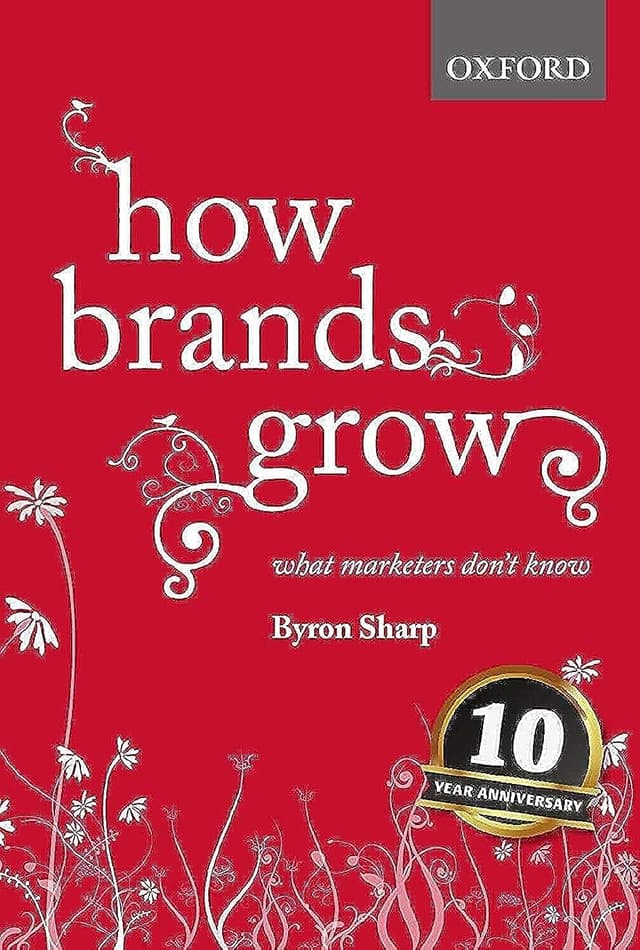Noah Brier | November 2, 2022
The Omnivorous Inspiration Edition
On creativity, dot connecting, and relevance
Recommended Products
A recommendation from a conversation about top-notch folding chairs in the WITI Subscriber Discord.

A recommendation from a conversation about top-notch folding chairs in the WITI Subscriber Discord.

The book makes it clear that one of the most critical jobs for marketing is finding ways to establish a place for a brand’s “distinct brand assets” in the heads of consumers by finding unique and creative ways to communicate.
Noah here. In 2009, Bob Isherwood, the former Worldwide Creative Director of the famed advertising agency Saatchi & Saatchi, gave a speech about creativity at an industry event called Dubai Lynx. Titled “ORE,” for originality, relevance, and emotional connection, he started with a video featuring the likes of Jimi Hendrix, steam trains, and the Guggenheim before getting into the meat of the talk: a nearly-thirty minute lecture about nanotechnology. Here’s an excerpt:
Which leads me to the group of threads that surprised me most when it became part of the nanotechnology tapestry; the group that has its roots in biochemistry and molecular biology. But having accepted that nanotechnologies were to do with structures and phenomena that have nanometre dimensions, as indeed we suggested more than thirty years ago, I should not have been surprised. DNA molecules and proteins have dimensions of nanometres and, as molecular biologists can manipulate the molecular structure of proteins and DNA, they can surely call themselves nanotechnologists, should they wish to do so.
If that seems out of place at an advertising conference, it’s because it was. Isherwood was illustrating a point about relevance by giving a speech that had been given a year prior as part of the BBC’s Reith Lectures by physicist, engineer, and former Vice Chancellor of the University of Cambridge, Alec Nigel Broers. Not entirely surprisingly, many didn’t take kindly to Isherwood’s approach. “It seemed ‘the point’, if ever there was one, had long ago left the auditorium and gone for a leisurely coffee,” wrote Campaign Middle East after the talk. “The preceding lecture, a transcript from a senior scientist, was very good but irrelevant to this particular audience, explained Isherwood. The point being that messages must be relevant. Had it really taken us almost 45 minutes to arrive at this?”
Why is this interesting?
That review wasn’t alone. Isherwood told me recently that his wife had called him in Dubai crying after seeing all the negative feedback online. But reading over the talk and looking back on the ideas being communicated, I think there are much more interesting threads to pull.
Starting simple, the basics of Isherwood’s thesis are right. Lots of good work has been done in the last decade to show the role of creativity and emotional resonance in successful advertising. If you haven’t read Byron Sharp’s How Brands Grow, it’s definitely worth the time. The book makes it quite clear that one of the most critical jobs for marketing is finding ways to establish a place for a brand’s “distinct brand assets” in the heads of consumers by finding unique and creative ways to communicate. I first heard about Isherwood’s talk from someone who was there—it was the only presentation they remembered from the event that was now over 13 years ago. Say what you will about the methods, but the impact was there.
More than that, though, I’m struck looking back at the content of the talk itself. Although I’m sure most in the audience had tuned out early—and it’s clearly one thing to read something complicated and another to have it spoken to you—but the speech originally given by Broers is about the explosion of nanotechnology as a result of combinatorialism. It’s making a case for many threads that have come together to support a new technology and industry. At its base, it’s about innovation and where ideas come from, two topics near and dear to the marketing industry (to the point where they’ve effective become just buzzwords). I’m sure there was hardly another talk that day in Dubai that failed to mention the word “innovation,” but here was an actual talk about how it happens in science that an industry like advertising could learn quite a bit from.
Finally, and most amusingly to me, just a few years later, in 2013, Ogilvy, another famous global advertising agency, made a lot of industry news for their work with IBM on an atomic-scale stop-motion animation called “A Boy and His Atom.”
Made to support IBM’s efforts in data storage, the video bills itself as “the world’s-smallest stop-motion film.” It was made by moving atoms around a small piece of copper at -260℃ and magnifying the action 100 million times.

While there’s no evidence linking Isherwood’s talk to this smart bit of marketing from Ogilvy and IBM, it’s hard not to walk away thinking those in the audience who tuned out that day missed an important opportunity to broaden their horizons. Inspiration often lurks in unexpected places. In the end, it reminds me a lot of a favorite quote of mine about design, marketing, and lots of other fields from Pentagram partner Michael Bierut. Explaining why he doesn’t often write and talk explicitly about “design,” Bierut explained that it’s because design isn’t really about design to him:
Over the years, I came to realize that my best work has always involved subjects that interested me, or — even better — subjects about which I've become interested, and even passionate about, through the very process of doing design work. I believe I'm still passionate about graphic design. But the great thing about graphic design is that it is almost always about something else. Corporate law. Professional football. Art. Politics. Robert Wilson. And if I can't get excited about whatever that something else is, I really have trouble doing good work as a designer. To me, the conclusion is inescapable: the more things you're interested in, the better your work will be.
We like to call WITI a place for the “intellectually omnivorous,” so I know I’m preaching to an already-converted crowd. But finding ideas and inspiration in unexpected places seems like one of the foundational parts of the creative process, and Isherwood’s talk about nanotech to a room of the uninterested feels like a perfect illustration of the point. (NRB)
Some Things You Missed by Not Being on WITI Subscriber Discord Yet
As we have mentioned, we now have a subscriber-only Discord up and running. If you want to join, follow this link, and then be sure to verify your subscription to get access to all the channels.
We had a good convo about Derek Thompson’s latest Atlantic piece about the “moneyball-ization” of everything. I have seen arguments like this before (which roughly argue that data is making everything boring), but I don’t really buy it. One really interesting point was about the lack of backtesting in arguments like this, making it seem like it was always inevitable that Marvel movies would take over Hollywood. While that seems clear now, just like Star Wars was not an inevitability in the 70s, superheroes were still a bet.
We had a good conversation about skillets (including the world's largest cast iron pan) that eventually led to a few recommendations for top-notch folding chairs, including the Stargaze Reclining Camp Chair and the Front Runner Outfitters Expander Camping Chair.
Quote of the Day:
I might need to make this into its own WITI, but here’s Noam Chomsky on large language models from Machine Learning Street Talk:
So there's no point in looking at its deficiencies. Cause it does nothing. All it does is waste a lot of energy in California. I should be more careful. It has some engineering and applications that can be used to improve, live transcription, for example, which I'm very happy about because I like to use it. I like bulldozers too, it's a lot easier than cleaning the snow by hand; but, it's not a contribution to science.
So it's okay. I mean if you want to use up all the energy in California to improve live transcription, well. Okay.
(NRB)
Quick Links:
Been doing a lot of camo research lately: Abbott Thayer and Concealing Coloration / Dublin NH (NRB)
Redditor acquires decommissioned Netflix cache server with 262TB of storage (NRB)
Nothing to It: the wisdom of New Yorker editor John Bennet (NRB)
Driver radio talking about Ross Chastain’s insane Nascar lap (CJN)
Visualizing the speed of light on earth (CJN)
WITI Classifieds:
We are experimenting with running some weekly classifieds in WITI. If you’re interested in running an ad, you can purchase one through this form. If you buy this week, we’ll throw an extra week in for free on any ad. If you have any questions, don’t hesitate to drop a line.
Nudge, get customer insights with ease. Try Nudge
Do you want to improve your life by tapping into behavioral science insights? Listen to the award-winning Behavioral Grooves podcast today! Listen to Behavioral Grooves
Another interesting newsletter: Making the case for good content, clear writing and the creative process. Subscribe to the Hand & Eye. Subscribe to Hand & Eye
A publication exploring the most interesting and innovative consumer businesses, products, and trends Join New Consumer
—
Thanks for reading,
Noah (NRB) & Colin (CJN)
—
Why is this interesting? is a daily email from Noah Brier & Colin Nagy (and friends!) about interesting things. If you’ve enjoyed this edition, please consider forwarding it to a friend. If you’re reading it for the first time, consider subscribing.

